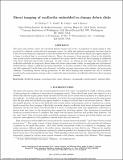| dc.contributor.author | Defrere, D. | |
| dc.contributor.author | Stark, C. | |
| dc.contributor.author | Cahoy, K. | |
| dc.contributor.author | Beerer, I. | |
| dc.date.accessioned | 2017-08-05T15:25:06Z | |
| dc.date.available | 2017-08-05T15:25:06Z | |
| dc.date.issued | 2012 | |
| dc.identifier.issn | 0277-786X | |
| dc.identifier.uri | http://hdl.handle.net/1721.1/110928 | |
| dc.description.abstract | The inner solar system, where the terrestrial planets formed and evolve, is populated by small grains of dust produced by collisions of asteroids and outgassing comets. At visible and infrared wavelengths, this dust cloud is in fact the most luminous component in the solar system after the Sun itself and the Earth may appear similar to a clump of zodiacal dust to an external observer. Hence, the presence of large amounts of dust in the habitable zone around nearby main-sequence stars is considered as a major hurdle toward the direct imaging of exoEarths with future dedicated space-based telescopes. In that context, we address in this paper the detectability of exoEarths embedded in structured debris disks with future space-based visible coronagraphs and mid-infrared interferometers. Using a collisional grooming algorithm, we produce models of dust clouds that simultaneously and self-consistently handle dust grain dynamics, including resonant interactions with planets, and grain-grain collisions. Considering various viewing geometries, we also derive limiting dust densities that can be tolerated around nearby main-sequence stars in order to ensure the characterization of exoEarths with future direct imaging missions. | en_US |
| dc.language.iso | en_US | en_US |
| dc.publisher | SPIE - The International Society for Optical Engineering | en_US |
| dc.subject | astronomical telescopes | en_US |
| dc.subject | circumstellar matter | en_US |
| dc.subject | coronagraphs | en_US |
| dc.subject | cosmic dust | en_US |
| dc.subject | extrasolar planets | en_US |
| dc.subject | infrared astronomy | en_US |
| dc.title | Direct imaging of exoEarths embedded in clumpy debris disks | en_US |
| dc.type | Article | en_US |
| dc.identifier.citation | Defrere, D., Stark, C., Cahoy, K., & Beerer, I. (2012). Direct imaging of exoEarths embedded in clumpy debris disks. Proceedings Of The SPIE - The International Society For Optical Engineering, 8442(8 pp.). doi:10.1117/12.926324 | en_US |
| dc.contributor.department | Space Telecommunications Astronomy and Radiation (STAR) Lab | |
| dc.contributor.department | Massachusetts Institute of Technology. Department of Aeronautics and Astronautics | |
